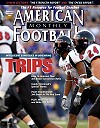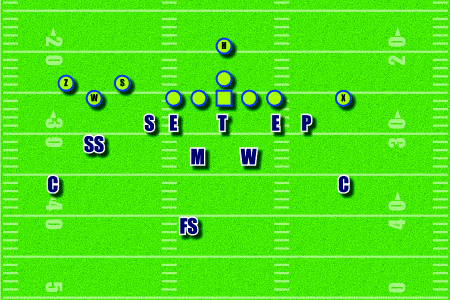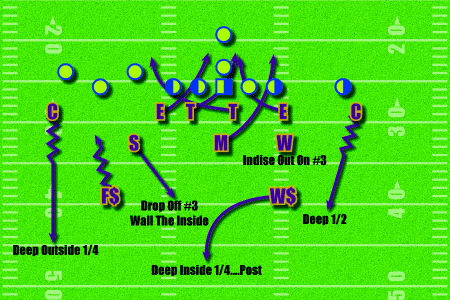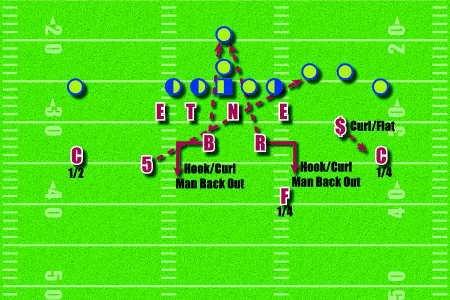AMERICAN FOOTBALL MONTHLY THE #1 RESOURCE FOR FOOTBALL COACHES
Article CategoriesAFM Magazine
|
Blanketing the Spread Formation: How to Defend Trips in the Open Field© More from this issueAs the advancement of offensive football continues, many teams have shifted away from the traditional one tight end, two back scheme that emphasizes an inside power running game – and have implemented some form of a spread offense. Steve Spurrier made a living off of it during the 1990’s and it has since spread like wildfire down to all levels of football. Offensive coordinators are finding a way to get their best athletes on the field making defenses account for up to six skill players on each play at a time and it has many defensive coordinators scratching their heads. What has presented a myriad of problems for defenses is the trips formation. By alignment, trips or trio as some programs call it, is defined as any 3x1 set, meaning three receivers to one side of the formation. This could be utilized with a bunch formation (three wide receivers) or can incorporate a tight end and two wide receivers to one side as well. But in order to defend the trips set, we must first try to find the method behind the madness of the formation. According to the coaches we spoke with, the general philosophy behind getting into a trips formation is basically three fold: 1. Spread the defense out and make them cover the entire field. 2. Create mismatches with better athletes; a linebacker may have to cover a running back or a bigger safety might have to run with a WR. 3. Getting a run advantage in the tackle box with better numbers at the point of attack. Mickey Matthews, head coach of 2005 D I-AA champion James Madison, breaks down defending the trips formation into two basic guidelines. “The first thing you have to account for is if all wide receivers go vertical right off the snap,” says Matthews. “Secondly, based on numerous film study you have to determine how good the receiver is on the backside of trips. If your corner is better than him, that solves a lot of problems. You can match up and play some type of man coverage.” According to Matthews, offenses try to put their best receiver away from the trips formation to create what usually can be a one on one with a corner. Many defenses tend to rotate their coverage to the trips side, leaving little or no help away. Matthews likes to generally stay in his base 4-4, cover 3 scheme, but will switch up coverages depending on what he sees in film study. “The key to being a good defense is not to do the same thing with your coverage twice,” says Matthews. “But you don’t want to do too much to confuse yourself or your kids. Good coaches can find the happy median in this.” But many defensive coaches find themselves constantly switching their personnel just to account for the speed of the offense. Jerry Holmes, the defensive coordinator of Hampton University, who led the Mid-Eastern Athletic Conference in scoring defense (14 ppg) this season, will use ten different nickel packages in coverage. He subsititutes an extra defensive back (nickel) while getting a bigger defensive lineman off the field. Holmes will use a three man front against a no-TE set, but will try to stay away from man to man coverage against trips. “When we see trips or a bunch set we will check to a cover 3 alignment right away because of the pick routes that teams use in that set. If we stayed in man coverage, teams will run “rub” routes where our defensive backs would get picked. Our strong safety might show man by getting in the face of their slot receiver, but we’ll back off and play cover 3 on the snap.” (See Diagram 1) 
Diagram 1 Hampton University: Trips Adjustment One of the common misconceptions is that a trips formation is a passing scheme. But according to Holmes, teams will overload the trips side and try to outflank defenses by running the football directly at the trips side because some defenses can become outflanked. If that doesn’t work, they may counter with some type of speed option or quick toss away from trips to get to the sideline. Holmes likes to play what he calls safety force to the trips side, so the strong safety, lined up on the number two receiver, can contain any strong side runs such as toss or outside zone to the trips side. “It helps so you don’t have a 300 lb. guard pulling and kicking out a 150 lb. corner,” says Holmes. “That’s defensive suicide.” Another option in defending trips is bringing pressure to get to the quarterback, forcing him to make a quick and sometimes poor decision with the football. Tim Schaffner, the defensive coordinator at Butler Community College in Kansas sees the trips formation every week in the Jayhawk Conference. His squad posted a league leading 48.5 sacks because of some of the schemes he uses to bring heat. He doesn’t worry much about the receivers on the field, it’s escapability of a signal caller that bothers him. “Our biggest concern in any type of spread offense is the guy calling the plays. We’re a zone pressure team. We’re worried about the type of guy that can sit back there and pick us apart, so we won’t let that happen. We’ll find numerous ways to get to him using line stunts up front, or delayed blitzes by the linebackers,” says Schaffner. Schnaffner believes all it comes down to is a numbers game up front. “We always try to outnumber how many guys they have at the line of scrimmage in order to block us. We’ll bring six if they have five without using the back. If they use the back and have six in pass protection, then we’ll bring seven,” he says. He’ll play what he calls “sky coverage” behind it, rotating the coverage to the trips side. “We’ll play quarter, quarter/half coverage with the free safety rotating to the trips side and the corner matched up on the single receiver side bailing out before the snap and playing the deep half to eliminate any one on one mismatches that could cause a long gain. He’ll always have help on any backside post with the other safety.” (See Diagram 2). 
Diagram 2 Butler's Stack Wizard | Sky Coverage It’s basically the same principle that David Tenison, the defensive coordinator uses at powerhouse Jenks HS in Oklahoma to defend trips. Tenison calls the quarter, quarter/half scheme Cover 9, but adds a wrinkle to it. “We’ll use something called Cover 9 ‘read’ to a trips team that likes to run the football. This usually indicates to us that they have a high tendency of running speed option away from trips, so we’ll read the single running back,” says Tenison. The Trojans base defense is a 4-3 scheme, but Tenison will keep tabs on who offenses have in the game while he’s up in the press box. Once he sees there is no tight end in the game, he’ll change personnel by replacing an outside linebacker with another nickel (5) defensive back. His two inside backers will key or read the single back to protect against the run. “The common thinking is that with the trips you’d overload one side and they would run to the other. We would even shade the front away from the trip side just so they won’t break contain.” (See Diagram 3). 
Diagram 3 Jenks' Cover 8 Trips Adjustment Even the traditional run-oriented Big 10 Conference has started to implement more one-back, four-wide receiver sets to take advantage of speed. It forced teams like Purdue, who was more known as an eight-man in the box, man pressure defense to play more zone coverage. According to Purdue defensive coordinator Brock Spack, the switch came because of the concern about getting beat deep. Spack will play most trips teams in a base 4-3 cover 2 scheme, but will always make sure he has enough support to stop the run on the weak side. According to Spack, when the offense comes out in a trips set, defending it lies in figuring out whether they want to spread you out and run or spread you out and pass. “Anytime you’re in a two deep shell in the secondary like we play here at Purdue, if a team comes out in a four wide receiver set you basically have two choices, but either way you have to compensate for that extra receiver. You can bump one of your linebackers out of the box to get a better angle on coverage or you can bring a safety down to account for him. We like to stay in cover two, so we’ll extend one of those backers. But you have to be sure you are protected against the weak side run game like speed option or trap.” When all else fails, spread offenses will play a game of chess by using a no-huddle setup, and seeing who makes the first move. They’ll line up right over the ball in a trips set and basically see how you adjust to it. It’s the same thing that a basketball team would do within the last seconds of a game to set up a final shot before calling a timeout. “It’s like what Peyton Manning is doing with the Colts,” says Holmes. “They’ll look to see what coverage you’re playing based on your secondary’s alignment and than decide where to go from there.” To combat this Holmes will disguise their coverage as much as possible before the snap using buzz terms that depict assignments – for example, “banana” might mean linebacker force, or “cherry” – for corner force. They are used to tell the defense who has contain responsibilities. When teams line up in a spread set without huddling against Jenks, and it happens often, Tennison will signal in a two digit number that will alert his players what coverage they will be playing. “I’ll call something like 29 so that our kids know if before the snap of the ball if it’s a 2x2 set (two receivers on each side) we will play cover 2. If it becomes a trips set we will play that cover 9 shell. It takes the guesswork right out of it for the kids, plus I’ll probably be yelling my head off from the sideline.” Matthews takes it one step further. “Sometimes our defense won’t even break the huddle until the QB is completely set and is calling his cadence. It works for now, but they’ll probably come up with something else to counter us. All it really becomes is a poker match, and the offense wants you to show you their hand first.” Contributing writer Mike Kuchar is currently coaching at Elmwood Park High School (NJ). He previously coached at Saint Peter’s College and Elmwood Park HS (NJ). As a player, he was an All-Northeast Conference defensive end at Sacred Heart Academy. |
|
| HOME |
MAGAZINE |
SUBSCRIBE | ONLINE COLUMNISTS | COACHING VIDEOS |
Copyright 2024, AmericanFootballMonthly.com
All Rights Reserved




